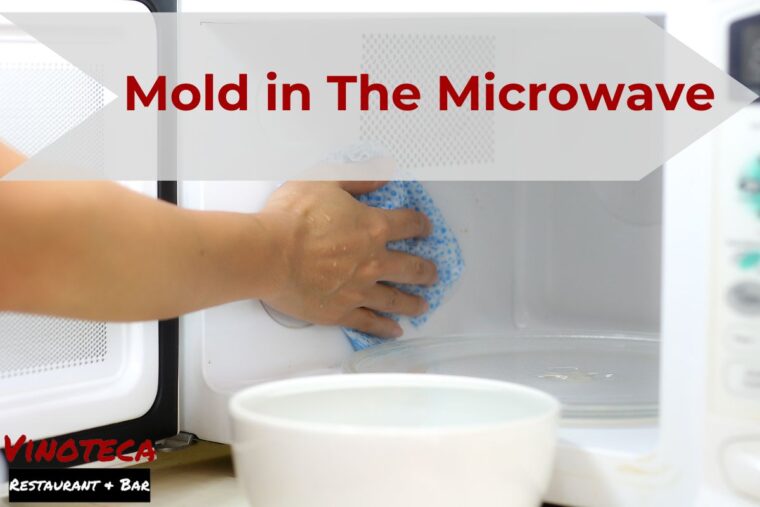Have you recently discovered mold in the microwave? If so, this article can help to educate you on what steps you need to take to clean and remove the fungi from the appliance.
However, you don’t have to suffer in silence: a few proactive steps can help rid your microwave of pesky mold and ensure it continues to produce safe and delicious meals for years to come!
This post will explain why mold has developed, a comprehensive cleaning process that should be done immediately upon discovery of the issue, and how long it may take for both thorough disinfection of your microwave or complete replacement if needed.
It’s important to ensure proper upkeep of any home appliances as they are expensive investments. Keep reading to learn more about removing mold from microwaves effectively and safely!
Signs and Symptoms of Mold in the Microwave
Mold can be difficult to detect as it is usually hidden away in nooks and crannies of the appliance. The following signs may indicate that there is an issue in your microwave:
- A musty smell when opening the door or after heating up food;
- Visible black, gray, or white growth on surfaces inside the microwave;
- Apparent water spots on inner walls;
- Discoloration/staining of interior surfaces.
Causes of Mold Growth in the Microwave
Mold growth in your microwave can be a nuisance and a potential health hazard. If left unchecked, it can spread to other areas of your kitchen and home, leading to respiratory problems and allergic reactions.
Knowing the causes of mold growth in your microwave will help you prevent it from happening and keep your kitchen safe and healthy.
The following are some of the most common causes of mold growth in the microwave:
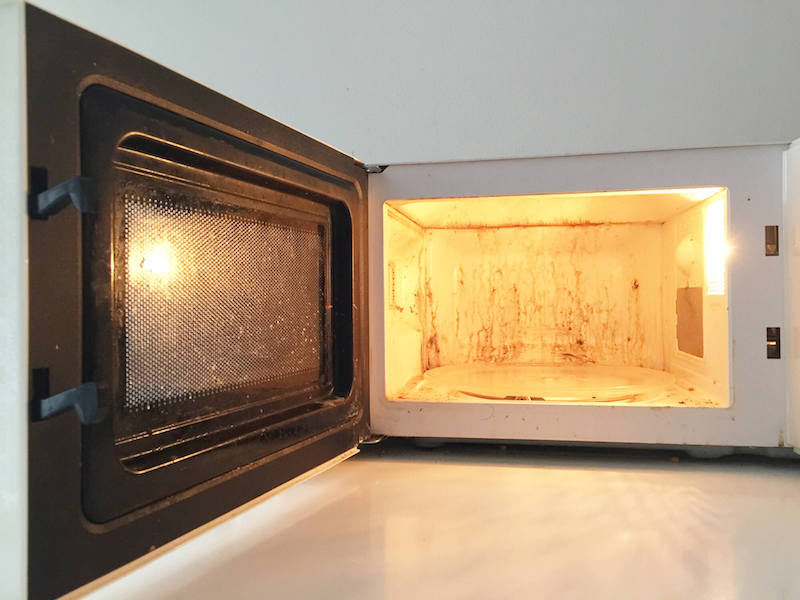
1️⃣ Moisture and humidity
One of the primary causes of mold growth in the microwave is the presence of moisture and humidity.
When you heat food in the microwave, steam is created, which can accumulate in the microwave’s interior and create a moist environment that is conducive to mold growth.
If you don’t wipe down the interior of the microwave after use, the moisture can linger and promote the growth of mold.
2️⃣ Lack of ventilation
Another factor that can contribute to mold growth in the microwave is the absence of proper ventilation.
If your microwave is not properly vented, the steam and moisture created during cooking will have nowhere to escape, leading to a buildup of humidity that can foster mold growth.
3️⃣ Food residue left in the microwave
Food residue left in the microwave can also contribute to mold growth. When food is left to sit in the microwave, it can create a breeding ground for mold spores to grow and spread.
It is essential to clean the microwave thoroughly after each use to prevent any food residue from remaining inside.
4️⃣ Poor cleaning habits
Finally, poor cleaning habits can also lead to mold growth in the microwave.
If you don’t clean your microwave regularly, food residue can build up, creating a moist environment that is conducive to mold growth.
It is essential to clean the microwave after each use and conduct a deep cleaning at least once a month to prevent mold growth.
Mold in the microwave can be a serious problem for homeowners. By understanding the causes of mold growth and taking steps to prevent it, you can help keep your microwave clean and safe for use.
How Can You Clean & Remove Mold from a Microwave?
If you do find mold growing in your microwave oven, follow these steps for proper removal and disinfection before use:
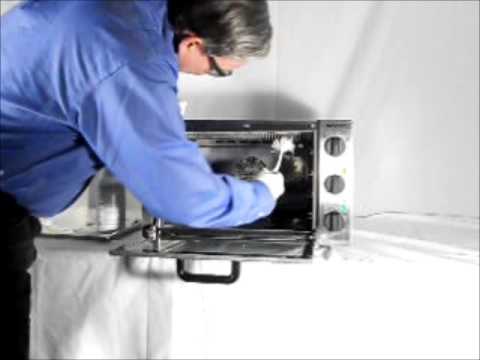
1️⃣ The first thing you should do is remove all food and dishes from the microwave, as well as any loose bits of debris.
2️⃣ Next, mix a solution of warm water and white vinegar in equal parts in a bowl.
3️⃣ Dip a cloth or sponge into the mixture and use it to wipe down the interior surfaces of your microwave, paying special attention to any areas with visible spots of mold growth.
4️⃣ Let this sit for about 10 minutes before rinsing off with clean water.
5️⃣ If there are still traces of mold remaining after this process, you can use a scrub brush to gently remove them. Be sure to be gentle in your approach and not press too hard on the cleaned surfaces, as this could damage the interior of your microwave.
6️⃣ Finally, use a damp cloth to wipe away any lingering dirt or debris from the inside and outside of the appliance. This will help ensure that all traces of mold are eliminated and prevent future growth.
Reader Question: How To Clean Microwave Properly – Easier Than You Think
What Is Mold & How Does it Form in a Microwave Environment
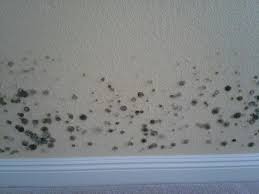
Mold is a type of fungus that usually occurs in warm, moist environments.
It typically appears as a slimy black or gray substance that lives on food, paper, wood, and other surfaces where oxygen is available.
This type of fungi can cause health problems when ingested or breathed in over long periods of time.
For example, mold spores are often inhaled during the cleaning process and may lead to allergic reactions such as sneezing, coughing, chest tightness, and red eyes.
In the case of your home’s microwave ovens, mold forms due to improper maintenance—usually from leaving food in the appliance for too long without cleaning it or from using it to heat up liquids with high water content (like soup or tea).
Both of these activities can lead to condensation, which creates the perfect breeding ground for mold.
Effects of Mold in the Microwave
The effects of mold in the microwave can be quite serious. Here are some of the most significant effects of mold growth in your microwave:

Health Risks Associated With Mold Exposure
Mold exposure can cause a variety of health problems, especially for people with respiratory issues or weakened immune systems.
When mold spores are inhaled, they can cause allergic reactions, such as sneezing, runny nose, and itchy eyes. In more severe cases, mold exposure can lead to asthma attacks, respiratory infections, and other serious health problems.
If you have mold in your microwave, it’s important to take action right away to prevent mold spores from spreading and causing health problems.
Decreased Efficiency Of The Microwave
Mold can also affect the efficiency of your microwave. When mold grows in the microwave, it can interfere with the electromagnetic waves that the microwave uses to cook food.
This interference can lead to uneven cooking and longer cooking times, which can be frustrating and time-consuming.
In addition, mold can also cause the microwave to overheat and malfunction, which can be dangerous.
If you notice any issues with your microwave, such as uneven cooking or unusual noises, it’s important to check for mold and take action to address the problem.
Unpleasant Odor And Taste In Food Cooked In The Microwave
One of the most noticeable effects of mold in the microwave is the unpleasant odor and taste that it can leave in food.
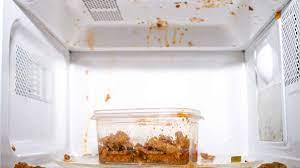
When mold grows in the microwave, it can release spores and toxins that can contaminate your food and leave it with a musty, unpleasant odor and taste.
This can be particularly problematic for people with sensitive taste buds, as the moldy taste can be difficult to mask or remove.
To avoid this problem, it’s important to clean your microwave regularly and avoid leaving food in the microwave for extended periods of time.
How to Prevent Mold Growth in a Microwave
Preventing mold in the microwave is important for both health and safety reasons. Here are some tips to help prevent mold growth:
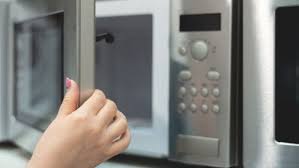
1. Clean spills and splatters immediately: If you spill food in your microwave, clean it up right away. This will prevent moisture from building up and creating a breeding ground for mold.
2. Use the vent fan: Always use the vent fan when microwaving food to help remove moisture from the air.
3. Keep the microwave clean: Wipe down the inside of your microwave with a damp cloth after each use. This will remove any food particles or moisture that may have accumulated.
4. Use a cover when heating food: Covering your food when heating it in the microwave can help prevent moisture from escaping and settling on the walls of the appliance.
5. Use a microwave-safe container: Make sure you are using a microwave-safe container when heating food in the microwave. This will prevent any harmful chemicals from leaching into your food and potentially creating an environment for mold growth.
6. Don’t let food sit in the microwave: Once your food is heated, remove it from the microwave immediately. Leaving it in the appliance can create a warm and damp environment that is perfect for mold growth.
7. Store food properly: Store food in airtight containers to prevent moisture from building up inside the container and creating a breeding ground for mold.
8. Use a dehumidifier: If your microwave is in a particularly humid environment, consider using a dehumidifier to help remove excess moisture from the air.
In conclusion, mold in the microwave can have serious effects on your health, the efficiency of your microwave, and the taste of your food.
To prevent mold growth, it’s important to clean your microwave regularly and avoid leaving food in the microwave for extended periods of time.
If you notice any signs of mold in your microwave, such as dark spots or a musty smell, it’s important to take action right away to prevent further growth and protect your health.
What to Do if You Missed the Signs of Mold Growth
If you’ve noticed signs of mold growth in your microwave but haven’t taken any steps to address the problem, it’s important to take action as soon as possible.
Here are some tips for removing mold from a microwave:
1. Unplug the appliance and remove all food and containers
Before beginning any cleaning process, unplug your microwave and remove all food and containers from inside the appliance.
2. Clean with an antibacterial solution
Wipe down all surfaces of the appliance with a cloth dampened with an antibacterial solution or diluted vinegar. This will help kill any existing mold spores and prevent new ones from forming.
3. Dispose of any contaminated materials
If there is any food or cooking utensils that have come into contact with mold, dispose of them immediately.
4. Use a dehumidifier
If the area around your microwave is particularly humid, consider using a dehumidifier to reduce the moisture levels in the air.
5. Ventilate the area
Open windows and doors regularly or use a fan to help increase airflow and reduce humidity inside your kitchen. This can help prevent mold growth in the future.
6. Prevent future growth
Be sure to clean your microwave regularly and avoid leaving food in it for extended periods of time to prevent any further mold growth.
You should also store food properly in airtight containers to keep moisture from building up inside them and creating an environment for mold growth.
By following these tips, you can help ensure that your microwave remains mold-free and that your food stays safe to eat. With a little bit of extra care, you can help keep your kitchen healthy and clean.
FAQs on Mold In The Microwave
How do you clean mold out of a microwave oven?
The best way to clean mold out of a microwave oven is to use an antibacterial cleaner or vinegar solution.
Wipe down all surfaces of the appliance with a damp cloth and dispose of any food or containers that have come into contact with mold.
You should also consider using a dehumidifier in the area and increasing ventilation to help prevent future growth.
How do you get mold out of a microwave without vinegar?

If you don’t have vinegar, you can still clean mold out of a microwave using an antibacterial cleaner.
Wipe down all surfaces of the appliance with a damp cloth and dispose of any food or containers that have come into contact with mold.
You should also consider using a dehumidifier in the area and increasing ventilation to help prevent future growth.
How long does it take to remove mold from a microwave?
The time frame for removing mold from microwaves depends on how quickly it’s discovered and how thorough the cleaning process is.
In most cases, it should take around 15 minutes to properly clean a microwave with mildew problems.
However, if the entire appliance is covered in mold, it may take several hours or even days to clean everything thoroughly.
Can I use bleach to remove mold from my microwave?
It’s not recommended that you use bleach to clean mold from your microwave as this can create toxic fumes and irritate your skin and eyes.
Instead, use an antibacterial solution or diluted vinegar as these are safer and more effective for killing mold spores.
Is it safe to use a microwave with visible signs of mold?
No, it is not safe to use a microwave with visible signs of mold. Mold can cause serious health problems and produce toxins that may be harmful if ingested.
If you notice any signs of mold in your microwave, take immediate action to clean the appliance and prevent further growth.
Summary Up
It’s important to ensure that any home appliances stay in good working order to keep both you and your family safe from potential health risks.
If you ever find mold growing inside of your microwave, follow the steps outlined in this article for proper removal and disinfection before use! With just a few minutes of effort, you can have a clean and sanitized microwave ready for cooking once again!
Thank you for reading this article about how to clean and remove mold in the microwave! We hope you found the information provided helpful and easy to understand.
If you have any further questions or need more information, please feel free to contact us. We’d be more than happy to help! Happy cleaning!
🔖 Note:
Always take safety precautions when handling and cleaning any electrical appliances.
- Be sure to unplug the device before beginning your work.
- Use protective gloves, eyewear, and a face mask if needed for extra protection from mold spores.
- Dispose of all materials used carefully afterwards to ensure that no mold spores are left behind in the area.

